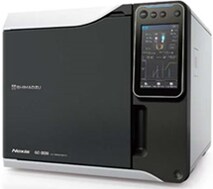GC

GC Gas Chromatography
Designed with the Analyst in Mind
World's Highest Sensitivity and Reproducibility
Exceptional Extensibility and Productivity
System Functions
A gas chromatograph (GC) is an analytical instrument that measures the content of various components in a sample.
Principle of gas chromatography: The sample solution injected into the instrument enters a gas stream which transports the sample into a separation tube known as the "column." (Helium or nitrogen is used as the so-called carrier gas.) The various components are separated inside the column. The detector measures the quantity of the components that exit the column. To measure a sample with an unknown concentration, a standard sample with known concentration is injected into the instrument. The standard sample peak retention time (appearance time) and area are compared to the test sample to calculate the concentration.


